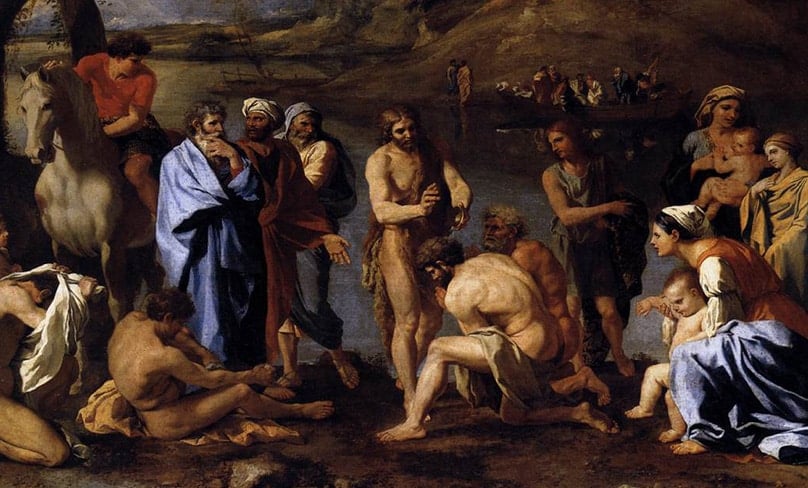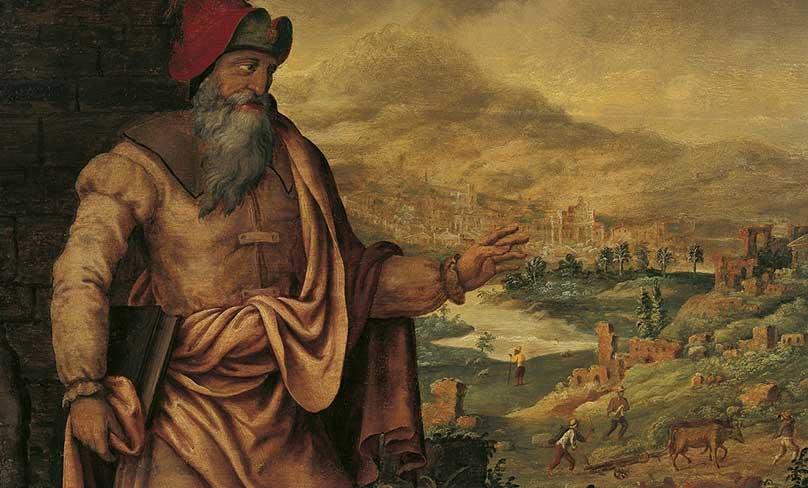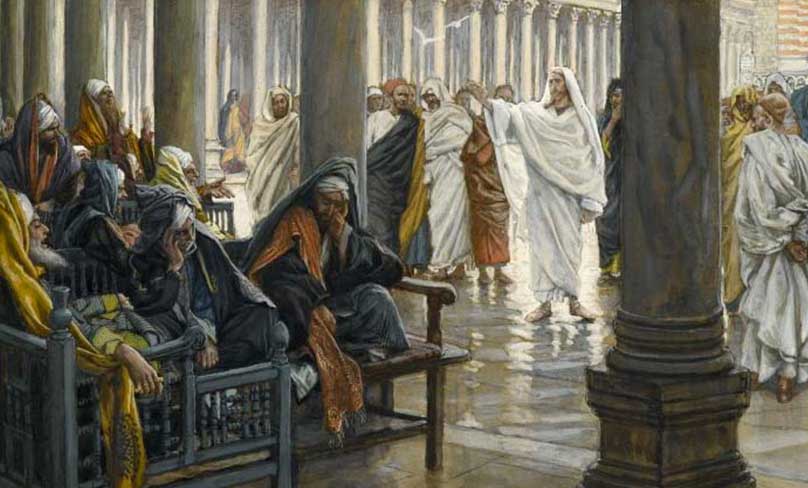
This is part 1 of Mark’s series for Advent on St John the Baptist
The season of Advent is bound up with the figure of John the Baptist or (as he is known in the East) John the Forerunner. He is a curious figure if, like me, you do not originally hail from the Christian tradition and just come at the gospel story fresh, not taking him for granted.
Why would Jesus need a herald or forerunner? Why would he need to be baptized for repentance and the forgiveness of sins (one of the most awkward features of the whole gospel narrative)? Did John invent baptism? Why does John call himself a voice crying in the wilderness? What’s the point of all this preliminary stuff? Why doesn’t Jesus, being God, just announce himself to the world and get going without the help of this strange, shouting figure out in the boondocks?
Over the next four weeks, I’d like to take a look at John, the last of the Old Testament prophets and the herald of the Messiah. But to do that, we need first to talk about God as a Creator, not of the universe, but of great literary art.
I’m an English major. The great thing about this is that, not only does it teach you to despise all the money you’ll never make, but it teaches you to see how great written art is done.
One of the basic tricks of the writer’s trade is known as foreshadowing. Foreshadowing is when something happens in a story that is going to become immensely more meaningful later. So when Frodo tells Gandalf that it was a pity Bilbo had not slain Gollum when he had the chance and Gandalf replies that the pity of Bilbo may rule the fate of many, Tolkien is packing into this small remark the whole unfolding meaning of the entire story. (Those of you who know the story, know what I mean. Those who have not read it: demand it for a Christmas present and get going! It’s a great story!)
Foreshadowing is important, not only as a literary device, but because we humans navigate our lives and understand our own stories by reference to other stories, especially the Great Stories, that have piled up around us over the millennia like leaves on a forest floor. When we watch The Matrix and Neo “goes down the rabbit hole” we understand his experience because of the reference to Alice in Wonderland.
Likewise, when he is told “Kansas is going bye bye” we understand that reference to The Wizard of Oz. Much of our communication to one another consists of references to stories we hold in common. So when I joke with my son, Luke, “I am your father”, the gag makes sense because of our common knowledge of Star Wars. When somebody says of some strange event, “There are more things in heaven and earth than are dreamt of in your philosophy, Horatio” that reference to the most famous ghost story in history—Hamlet—gives us a common frame of reference for talking about the uncanny.
This way of communicating is vital for understanding Scripture and, in particular, the New Testament since both the characters in and authors of the New Testament are people whose minds are utterly marinated in the imagery and events of a common story: the Old Testament. These are people who habitually understand themselves and their world by means of reference to it. And they have formed that habit of thought, paradoxically, because the authors of the Old Testament do it too.

What do I mean?
Consider the relationship of the book of Genesis to the book of Exodus. What many people don’t understand is that Genesis is, if you will, prefatory remarks. The main book of Torah, and therefore, of the whole Old Testament, is Exodus, not Genesis. Exodus is the mirror by which the Jewish people understand who they are, where they come from, and how they live in relationship to the God of Israel in the covenant made at Sinai. Genesis is the introductory story that leads to Exodus, the main story.
So, for instance, in Genesis, the world emerges from “the deep” in the creation narrative just as Israel is born in the passage through the waters of the Red Sea. When the human race sins and falls and eventually requires chastisement (as Israel will do in the sin of the Golden Calf) it is cleansed and purged in the Great Flood and emerges again to new life just as Israel is cleansed and purged and enters the Promised Land by passing through the waters of the river Jordan.
In the creation narrative, what we see is not a scientific account of creation, but a liturgical one. Creation is pictured as the erection of a macro-cosmic Temple with the image of God—man and woman—set in the Holy of Holies of this gigantic temple just as the Ark of the Covenant was placed in the Holy of Holies in the temple at Jerusalem. Israel will see its experience as a nation reflected in the world described by Genesis and will likewise go on to see its ongoing experience in light of the peculiar revelation vouchsafed to it in the Exodus and the covenant at Sinai.
It will also see its history as an unfolding of God’s revelation to it. So the rise of prophets such as the archetypal prophet Elijah will be seen as the assurance that God remains with his people and continues to shepherd them, no matter how corrupt the monarchy (or the people) become.
And the curious function of the prophets will be twofold. On the one hand, the prophets will keep calling the nation back to fidelity to their covenant with God at Sinai. When the nation is torn apart by civil war and splits into Judah (faithful to the house of David) and Israel (completely apostate and doomed to destruction by their Assyrian conquerors), the prophets plead with both nations to return to the teaching of Moses and their relationship with God. So one function of the prophets is to look back to the story of Israel.
But the other purpose of the prophets is to look forward to what God will do to save Israel. And the prophets do this precisely by invoking the imagery of what has already happened in order to teach Israel what is yet to come. So one of the most famous prophetic passages in the Old Testament comes after the hammer blows of the Babylonian exile have fallen on the kingdom of Judah, resulting in the mass deportation (today we would call it “ethnic cleansing”) of the whole nation under Nebuchadnezzar.

Just as the prophets had warned, Judah and the monarchy descended from David were smashed to atoms in punishment for their infidelity to God, starting around 597 BCE. But that was not the end of the story, because God also promised they would be restored to their homeland. And the way in which the prophet Isaiah spoke of this promise was to evoke the Exodus:
Comfort, comfort my people, says your God.
Speak tenderly to Jerusalem,
and cry to her
that her warfare is ended,
that her iniquity is pardoned,
that she has received from the Lord’s hand
double for all her sins.
A voice cries:
“In the wilderness prepare the way of the Lord,
make straight in the desert a highway for our God.
Every valley shall be lifted up,
and every mountain and hill be made low;
the uneven ground shall become level,
and the rough places a plain.
And the glory of the Lord shall be revealed,
and all flesh shall see it together,
for the mouth of the Lord has spoken.” (Is 40:1–5)
Isaiah looks back to the last time God made a highway in the wilderness—the Exodus—to give Israel the hope of a future after the catastrophe of the Babylonian Exile.
But he does more than that. He also tells the dispirited exiles that the killing of Zedekiah and his sons—the last kings of Judah—is not the end for the House of David. He looks back to the promises given David that one of his sons will always be on the throne (2 Samuel 7:11-16) and tells Israel that this promise will be kept. A “branch” will grow out of the felled stump of Jesse (David’s father):
There shall come forth a shoot from the stump of Jesse,
and a branch shall grow out of his roots.
And the Spirit of the Lord shall rest upon him,
the spirit of wisdom and understanding,
the spirit of counsel and might,
the spirit of knowledge and the fear of the Lord.
And his delight shall be in the fear of the Lord. (Isaiah 11:1-3)
And so the prophets go on to tell the Jews that this “Son of David” who has been anointed by the Spirit (“Messiah” (Hebrew) and “Christ” (Greek) both mean “anointed one”) will come in due time. But like typical Jewish prophets they look back into Israel’s long story to understand their future. Micah looks so far back that he actually traces Messiah’s origins to eternity:
“But you, O Bethlehem Ephrathah,
who are little to be among the clans of Judah,
from you shall come forth for me
one who is to be ruler in Israel,
whose origin is from of old,
from ancient days.” (Micah 5:2)
The Davidic ruler who is to come is somehow to be older than David, while still his son. It’s a puzzle that is also reflected in Psalm 110, a coronation ode for a Davidic king. This psalm, universally understood by the Jews of Jesus’ day as a reference to Messiah, contains a puzzle that Jesus himself pointed out:
“Now while the Pharisees were gathered together, Jesus asked them a question, saying, “What do you think of the Christ? Whose son is he?” They said to him, “The son of David.” He said to them, “How is it then that David, inspired by the Spirit, calls him Lord, saying, ‘The Lord said to my Lord, Sit at my right hand, till I put your enemies under your feet’? If David thus calls him Lord, how is he his son?” And no one was able to answer him a word, nor from that day did any one dare to ask him any more questions.” (Matthew 22:41-46).

The point is that Messiah’s authority is not merely due to his Davidic descent, but to his divine origins. Jesus, like a typical rabbi, leaves us to do the math ourselves rather than spelling it out for us. And, like a typical prophet, he uses the stories and history of Israel in order to help his audience understand the nature of the story they are living right now and where God is leading them next.
All of which brings us back to John the Forerunner. For John’s mission is likewise only comprehensible in light of the history of the Chosen People. He makes this extremely clear by citing that passage from Isaiah 40 we see up above. He understands himself to be that voice crying in the wilderness, saying, “Prepare the way of the Lord!” and says as much in John 1:23. He sees the events that are about to unfold in Israel as the ultimate culmination of the history of Israel. Interestingly, he himself denies that he is Elijah (John 1:21). That is, he denies the rumor that he is literally Elijah returned from heaven or somehow reincarnated. But Jesus, with greater insight, affirms that, in another sense, he is indeed a kind of Elijah, just as the prophet Malachi had foretold when he wrote: “Behold, I will send you Elijah the prophet before the great and awesome day of the Lord comes” (Malachi 4:5).
“And they asked him, ‘Why do the scribes say that first Elijah must come?’ And he said to them, ‘Elijah does come first to restore all things; and how is it written of the Son of man, that he should suffer many things and be treated with contempt? But I tell you that Elijah has come, and they did to him whatever they pleased, as it is written of him.’” (Mark 9:11-13)
John, acting in “the spirit and power of Elijah” (Luke 1:17) fulfils the mission of Elijah in a way that Elijah himself did not. For, of course, the doom of John, as of all the prophets, is to be murdered by the very people to whom he is sent. Because the prophet is, in the end, a disciple of Jesus Christ and so must share his fate of rejection and death. So John goes before Jesus in every sense of the word, heralding him not only to the living, but to the dead whom he will join in the tomb and who will be rescued in the resurrection of Jesus. By his death, he foreshadows the great death of the great Davidic king and the life that will come through it.
